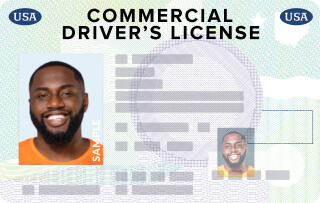

All your missed questions are saved
automatically for extra practice.




It's a practice test that's automatically made up of all your missed questions. Once you finish this test, you’ll be able to revisit your Challenge Bank™ to practice and sharpen your skills.
View All PlansAdding difficult questions to Challenge Bank™ is an exclusive Premium feature. Unlock access to 650+ exam-like questions, a Pass Guarantee, personalized study plans, and more.
View All Plans- Updated for April 2025
- Based on 2025 WY commercial driver's license manual
Free WY CDL Double/Triple Trailers Practice Test 2025
Do you want to drive combination trucks with two or even three trailers? Good news! Besides Double Pup vehicles, Wyoming also allows the following types of Long Combination Vehicles (LCVs) on officially designated routes (primarily I-80): Rocky Mountain Double, Turnpike Double, and Triple. (You may need an oversize permit if your vehicle exceeds the state’s length or weight limits.) However, only a minority of truck drivers are qualified and trained to operate LCVs, so demand for such drivers is high.
In Wyoming, the logistics and freight sector heavily uses double trailers for efficient transport. FedEx Freight, TForce Freight, and XPO Logistics use double or triple trailers for freight distribution. In the energy sector, HF Sinclair uses Rocky Mountain Doubles and Triples for fuel distribution. Peabody Energy and Arch Resources use double coal hoppers to transport coal from mines to rail. Cargill and ADM (Archer Daniels Midland) use double grain hoppers to transport wheat and corn. Tyson Foods and JBS USA use double livestock trailers to transport cattle.
To legally pull doubles or triples, you must hold a Class A CDL and obtain a Double/Triple (T) endorsement on your CDL. Wyoming also requires drivers of Turnpike Doubles or Triples to complete an LCV Driver Training Program.
To get the T endorsement, you must pass the Double/Triple knowledge test. This official test covers such topics as safe handling, air brakes on doubles and triples, coupling and uncoupling, pre-trip inspections, emergency situations, and state and federal regulations on doubles and triples. (No special skills test is required for this endorsement.)
This knowledge test is based on the official Wyoming CDL manual (Wyoming CDL Handbook 2025), especially Chapter 7: Doubles and Triples. We can help you pass the knowledge test on your first try – something you can’t ensure just by reading the manual.
This is the first of our five Wyoming Doubles and Triples Endorsement Practice Tests. It’s based on Chapter 7 of the official CDL manual, just like the Double/Triple knowledge test. It’s up to date as of April 2025. The 20 multiple-choice questions and answers on this practice test deal with air lines, converter dollies, coupling, emergency situations, following distance, and rearward amplification.
Our AI Assistant can give you a hint or further elaboration if you get stuck on a question or an immediate explanation of the correct answer if you still miss the question. You can also ask it your own questions about driving.
This practice test isn’t timed; take all the time you want. You can also retake this practice test as often as you wish until you’ve mastered the material.
- Perfect for first-time and renewal CDL/CLP applicants, and those adding endorsements
- Triple-checked for accuracy
What you need to know

What to expect on the actual WY DOT exam
questions
correct answers to pass
passing score
List of questions (classic view)
- When you're pulling more than one trailer, which trailer should be the first one behind the tractor?
- Which of these statements about quick steering movements and doubles/triples is true?
- You are driving a 100-foot double trailer combination at 50 mph. The road is dry and visibility is good. You should keep at least ____ seconds of space ahead of you.
- Before connecting a converter dolly to a second or third trailer, you should check the height of the trailer. The trailer height is right if
- You are driving a 100-foot double trailer combination at 30 mph. The road is dry and visibility is good. You should keep at least ____ seconds of space ahead of you.
- With the hand valve on, you should test the trailer brakes by opening the service line valve at the rear of the rig. When you do this, you should hear
- Empty trucks
- Which of these statements about handling doubles and triples is true?
- Before you can supply air to the air tanks of a second trailer, you need to
- You are driving with double trailers and must use your brakes to avoid a crash. For emergency braking, you should
- How can you be sure that you supplied air to a second trailer?
- What is likely to happen if the pintle hook is unlocked while the dolly is still under the second trailer?
- You want to hook your combination to a second trailer that does not have spring brakes. To do this without wheel chocks, you should
- Which of these statements about managing space to the sides is true?
- The crack-the-whip effect that troubles trucks with trailers is most likely to tip over
- You are visually checking the coupling of a converter dolly to the rear trailer. How much space should there be between the upper and lower fifth wheel?
- You are pulling doubles. A set of trailer wheels goes into a skid. Which of the following is most likely to occur?
- You are doing a walk-around inspection of a double or triple trailer rig. You should be sure that the converter dolly air tank drain valves are ______ and the pintle hook is _______.
- A converter dolly is
- A converter dolly consists of a ______ wheel and ________ axles.
- Alabama: Test 1 / Test 2
- Alaska: Test 1 / Test 2
- Arizona: Test 1 / Test 2
- Arkansas: Test 1 / Test 2
- California: Test 1 / Test 2
- Colorado: Test 1 / Test 2
- Connecticut: Test 1 / Test 2
- Delaware: Test 1 / Test 2
- District of Columbia: Test 1 / Test 2
- Florida: Test 1 / Test 2
- Georgia: Test 1 / Test 2
- Hawaii: Test 1 / Test 2
- Idaho: Test 1 / Test 2
- Illinois: Test 1 / Test 2
- Indiana: Test 1 / Test 2
- Iowa: Test 1 / Test 2
- Kansas: Test 1 / Test 2
- Kentucky: Test 1 / Test 2
- Louisiana: Test 1 / Test 2
- Maine: Test 1 / Test 2
- Maryland: Test 1 / Test 2
- Massachusetts: Test 1 / Test 2
- Michigan: Test 1 / Test 2
- Minnesota: Test 1 / Test 2
- Mississippi: Test 1 / Test 2
- Missouri: Test 1 / Test 2
- Montana: Test 1 / Test 2
- Nebraska: Test 1 / Test 2
- Nevada: Test 1 / Test 2
- New Hampshire: Test 1 / Test 2
- New Jersey: Test 1 / Test 2
- New Mexico: Test 1 / Test 2
- New York: Test 1 / Test 2
- North Carolina: Test 1 / Test 2
- North Dakota: Test 1 / Test 2
- Ohio: Test 1 / Test 2
- Oklahoma: Test 1 / Test 2
- Oregon: Test 1 / Test 2
- Pennsylvania: Test 1 / Test 2
- Rhode Island: Test 1 / Test 2
- South Carolina: Test 1 / Test 2
- South Dakota: Test 1 / Test 2
- Tennessee: Test 1 / Test 2
- Texas: Test 1 / Test 2
- Utah: Test 1 / Test 2
- Vermont: Test 1 / Test 2
- Virginia: Test 1 / Test 2
- Washington: Test 1 / Test 2
- West Virginia: Test 1 / Test 2
- Wisconsin: Test 1 / Test 2
- Wyoming: Test 1 / Test 2
Your go-to, trusted source
Experience the Driving-Tests differenceOur commitment to accuracy and quality in our practice tests
Explore our rigorous, multi-tiered verification process that ensures each question mirrors the official manual for unparalleled accuracy.

At Driving-Tests.org, we understand the importance of reliable and accurate practice tests to help you prepare for your DMV exam. That's why we've developed a meticulous process to create and continually update our practice questions, ensuring they reflect the most current driving laws and regulations.
Here's an inside look at how we maintain the highest quality in our practice tests.
Content Creation and Verification Process
- Alignment with Official Manuals:
Every question we develop is based on the most recent version of each state's official driving manual. Our team regularly monitors each state DMV's website for the latest updates to ensure our practice tests are always aligned with the most current information. - Community Feedback Integration:
We leverage feedback from our vast community of users to understand which topics are most frequently tested. This helps us focus on the areas that are most relevant and beneficial for your preparation. - Expert Content Creation:
Our in-house editor, Steven, who has extensive experience in driver education, crafts each question with precision. He conducts a thorough review of each question against the official manuals to ensure accuracy. - Rigorous Review Process:
Once Steven has finalized a set of questions, our team conducts a joint review session. This second level of scrutiny involves content accuracy, proofreading, and fact-checking to eliminate any errors. - User Feedback Mechanism:
After a question goes live on our site, we keep the lines of communication open. Each question features a feedback button, inviting users to report any issues or errors. This continuous feedback loop allows us to address and rectify any concerns promptly. - Responsive Updates:
In line with our commitment to accuracy, we quickly update our practice questions to reflect any changes in the DMV manuals. Additionally, we update the free electronic copy of the state's driver's license manuals on our site, typically within a few days after the DMV publishes them.
Our thorough quality control process ensures that you have access to practice tests that are as accurate and up-to-date as possible. We believe in the power of well-prepared drivers and are dedicated to providing you with the best study tools to help you succeed on your DMV exam.
Before you see your results, discover how CDL Premium helps you:
- Real CDL Exam-Like Wyoming QuestionsQuestions match official CDL tests
- Official FMCSA-approvedELDT Certification included
- 99.06% Verified Pass Rate vs. 49% AverageProven success, specialized for CDL drivers



Trusted by 1.15 Million drivers

